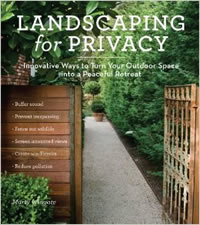 Marietta and Ernie O’Byrne are very clear about their gardening goals. They are not interested in low-maintenance gardening “with orderly shrubs, surrounded by chipped mulch, and plants that don’t touch,” but neither do they care for plant thugs that dominate their neighbors. To achieve these ends, much maintenance is required and they relish this work. “A Tapestry Garden: The Art of Weaving Plants and Place” captures these ideals as they have been expressed in their two acres of gardens on a farm in Eugene.
Marietta and Ernie O’Byrne are very clear about their gardening goals. They are not interested in low-maintenance gardening “with orderly shrubs, surrounded by chipped mulch, and plants that don’t touch,” but neither do they care for plant thugs that dominate their neighbors. To achieve these ends, much maintenance is required and they relish this work. “A Tapestry Garden: The Art of Weaving Plants and Place” captures these ideals as they have been expressed in their two acres of gardens on a farm in Eugene.
The O’Byrnes are famous for their hellebores, so I wasn’t surprised to read about their woodland gardens with profiles of shade loving favorites, including trilliums, arisaemas, and podophyllum. But I didn’t know they had large swaths of sun, too. These includes a riotous summer perennial border (a “full-flowered buxomness of leaning, mingling, sprawling growth”) and a chaparral garden, that recreates the look of the southwest, albeit with plants that can survive a Pacific Northwest wet winter and spring.
In reading this latter chapter, I was reminded of the books by Beth Chatto, especially “The Gravel Garden” (2000), one of my favorite all-time gardening books. The O’Byrnes are not afraid to experiment. The writing (primarily in Marietta’s voice) recounts all the successes and failures in a matter-of-fact way and quietly expounds their right place, right plant philosophy throughout their several garden settings and microclimates.
Both Marietta and Ernie grew up loving nature. Both had college degrees in biology and worked together in their own landscape management company for much of their careers, but when it came to their own garden, they made plenty of horticultural mistakes, especially in the early years. While this at first seems like a book for the gardening elite, I encourage beginners to give it a read. You will be amused by the authors’ misfortunes and encouraged to shrug off your own failures and try again.
As they spent more and more time in their own garden, the authors eventually curtailed some of the maintenance business to start their own nursery. This latter continues today as a wholesale business exclusively selling hellebores. A chapter highlights the beauties they have developed, especially the Winter Jewels series, with stunning photographs. This book also includes a very helpful chapter on their maintenance practices, and maps of the garden inside both covers, in case you get lost during the written tour.
The O’Byrnes even sleep in their garden, enjoying the night fragrances of their summer, sunny perennials and the hummingbirds and other pollinators that are on wing at first light. Their plant palette is very broad, including many natives but also challenging-to-grow plants from around the world. Many of these are grown from seed – often there is no other way to obtain these plants. They have decided, “harmonious chaos is possible in a garden, with denizens from multitudes of countries of origin. Would that we humans could be as comradely as is the diverse plant world here represented.”
Excerpted from the Fall 2018 Arboretum Bulletin.
 Consider “The Intimate Garden” for very detailed examples of highly individualized garden spaces, with an emphasis on hardscape and ornaments. While both author Brian Coleman and photographer William Wright are from Seattle and the gardens are mostly on the west coast, examples from the east coast and even England are included, making this a very diverse selection of design styles and plant material.
Consider “The Intimate Garden” for very detailed examples of highly individualized garden spaces, with an emphasis on hardscape and ornaments. While both author Brian Coleman and photographer William Wright are from Seattle and the gardens are mostly on the west coast, examples from the east coast and even England are included, making this a very diverse selection of design styles and plant material. “Landscaping for Privacy” by Marty Wingate is very practical and addresses annoying issues like siting the recycle bins, and how to embrace wildlife or pets without letting them run amok, while empowering you to create a space that is very distinctly your own. Relatively few gardening books address fences and hedges in any depth, but for Wingate “screening hedges become more than shrubs planted in a line; they create a green, living wall, incorporating the design elements of sequence and repetition to pull together the landscape.”
“Landscaping for Privacy” by Marty Wingate is very practical and addresses annoying issues like siting the recycle bins, and how to embrace wildlife or pets without letting them run amok, while empowering you to create a space that is very distinctly your own. Relatively few gardening books address fences and hedges in any depth, but for Wingate “screening hedges become more than shrubs planted in a line; they create a green, living wall, incorporating the design elements of sequence and repetition to pull together the landscape.” Love Albrecht Howard’s first book fills a gap in our collection. To my knowledge, it is the only recent book on running a garden design business that is written for plant lovers who may not have formal horticultural or business training, but who do have a fair amount of common sense and are willing to get their hands (and feet!) dirty learning. The author certainly approves of formal education, recommending that prospective designers take courses, but she knows firsthand that hands-on experience gained through internships, volunteer work, and garden shows, as well as time spent with gardening books and magazines can be even more valuable than coursework. Indeed, fifteen out of twenty chapters focus on day-to-day operations, including best gardening practices, rather than on estimating costs, hiring staff, and other money-related aspects of the business.
Love Albrecht Howard’s first book fills a gap in our collection. To my knowledge, it is the only recent book on running a garden design business that is written for plant lovers who may not have formal horticultural or business training, but who do have a fair amount of common sense and are willing to get their hands (and feet!) dirty learning. The author certainly approves of formal education, recommending that prospective designers take courses, but she knows firsthand that hands-on experience gained through internships, volunteer work, and garden shows, as well as time spent with gardening books and magazines can be even more valuable than coursework. Indeed, fifteen out of twenty chapters focus on day-to-day operations, including best gardening practices, rather than on estimating costs, hiring staff, and other money-related aspects of the business. Val Easton’s warm and clear writing style is very familiar, but her subject matter in this book breaks new ground as she applies the architectural concepts of patterns, or putting “human instincts into words,” to garden setting. Throughout she “helps us to understand why we feel comfortable in a space” and why, in other places, we don’t. The patterns are not unfamiliar: Scale, Garden Rooms, Ornamentation, Containers, etc., but some associations may be new, such as grouping Patios, Sheds and Focal Points under destinations. This makes it important to read the book as a whole, even though you’ll return to favorite sections again and again for specifics. A short review of favorite plants concludes the book, but these are just one more pattern in the larger design.
Val Easton’s warm and clear writing style is very familiar, but her subject matter in this book breaks new ground as she applies the architectural concepts of patterns, or putting “human instincts into words,” to garden setting. Throughout she “helps us to understand why we feel comfortable in a space” and why, in other places, we don’t. The patterns are not unfamiliar: Scale, Garden Rooms, Ornamentation, Containers, etc., but some associations may be new, such as grouping Patios, Sheds and Focal Points under destinations. This makes it important to read the book as a whole, even though you’ll return to favorite sections again and again for specifics. A short review of favorite plants concludes the book, but these are just one more pattern in the larger design.